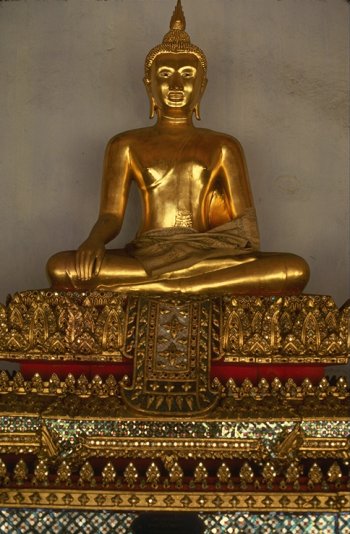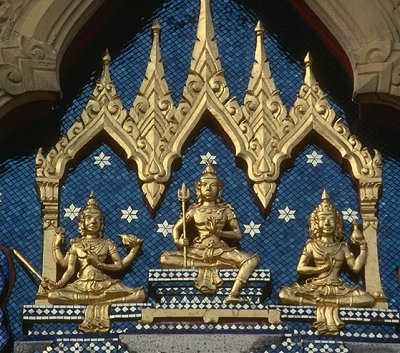India and Southeast Asia
by Dr. Sushama Arur
First Online: December 28, 2004
Page Last Updated: December 07, 2024
South East Asia is in the limelight now since the tsunami hit the Sumatra Island and devastated men and material in great number. It had its repercussions on Indian east coast, the worst hit being the coastal Tamilnadu. So I thought it was important to remember the Indian nexus with rest of Southeast Asia.
In the ancient past Indians from her east coast traveled to the shore of the present Indonesia and her neighbors, built empires and conquered those areas culturally. India maintained trade as well as cultural relations with Burma, Siam (Thailand), Malaya (Malaysia), Kambhoj (Cambodia), Annam and the East Indies (Sumatra, Java, Bali, Borneo etc). These regions were referred to as Suvarnabhumi and Suvarna dwipa meaning golden island and golden land. The Buddhist Jatakas refer to Indian merchants sailing from Tamralipti (coast of Orissa ) or Bharukachcha (Broach in Gujarat) to get riches. Brihat katha of Gunadhya and Kathasritsagar, both works of ancient India give us several stories of merchants going to Suvarnadvipa for trade. Buddhist texts also speak of trade contacts with South East Asia. Most important Hindu kingdom in Sumatra was Srivijaya, which established a vast empire comprising Malaya the present Malaysia. It became a great center of Buddhism. Sailendra empire became powerful in the 8th century comprising Sumatra, Java, Malaya. Foreign writers have referred to the empire's greatness and riches. The empire had cultural and commercial contacts with South India and Chinese. Buddhism spread in this empire and splendid monuments were built like Chandi Kalasam, Barabdur in Java.
Corel Professional Photo/Kamat's Potpourri
Statue of Buddha in Thailand
Statue of Buddha from Wat Sraket - Bangkok, Thailand
Bali an island to the east of Java still retained Hindu culture and religion. Champa (South Vietnam), Kambuja (Cambodia, Thailand) also had Hindu kingdoms India's contribution to the cultural heritage of South East Asia in various fields of human activities is immense. The inhabitants readily accepted the cultural conquest; though it was never forced upon the people. The most important contribution of India is in the religious field - Buddhism, Saivism, Vaishnavism entered into South East Asia.
The Sanskrit language and literature spread here. Large numbers of Sanskrit inscriptions are found in Burma, Siam, Malaya, Cambodia, Annam, Java, Sumatra and Borneo. It was in Indo-China [Funan, Champa and Kambuja] that the Sanskrit language and literature was widely prevalent. Next to religion and literature, the greatest influence of Indian culture was felt in the domain of art. The greatest monument of art and architecture is Barabdur Stupa which was built during the period of 750-850 AD under Shailendra kings. It is regarded as one of the wonders of the world. It has series of sculptured panels, about 1500 in number and about 432 images of meditative Buddhas. The Lara Jongrang group of temples in Java is the next best consisting of eight main temples and 148 small temples. The Shiva temple in the center is the most magnificent. The famous tourist spot Angkor Vat in Kambuja is a stupendous monument, which was dedicated to Vishnu, built in1122 AD by King Surya Varman II. A mile to the north of Angkor Vat lies Angkor thom, the capital city built by Jaya Varman VII.
Corel Professional Photo/Kamat's Potpourri
Hindu Icons
Wat Trimitr - Bangkok, Thailand
In Myanmar (Burma) more than 800 to 1000 temples are found. Anand temple of Pagan is a veritable museum of stone sculptures.
India owes a great deal to those early Hindu settlers and Buddhist monasteries who played a remarkable role in bringing peaceful penetration of their religion, social traditions and literary and architectural activities in these far off areas. Now the earthquake in Sumatra has its repercussions on Indian coast too bringing devastation to the people at large.
![]()
See Also:
 Contributor
Sushama Arur, Ph.D. is a historian and educator living in Bangalore. See
her other articles on Temples of Kerala
and Tourism of Goa Contributor
Sushama Arur, Ph.D. is a historian and educator living in Bangalore. See
her other articles on Temples of Kerala
and Tourism of Goa |

